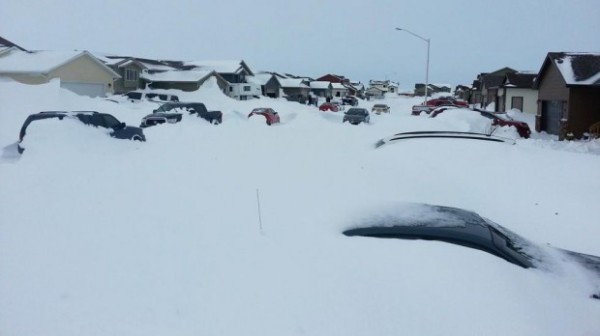
Some ranchers still aren’t sure how many animals they lost, because they haven’t been able to track down all of their cattle. Snowdrifts covered fences, allowing cattle to leave their pastures and drift for miles.
“Some cattle might be flat buried in a snow bank someplace,” said Shane Kolb of Meadow, who lost only one cow.
State officials are tallying livestock losses, but the extent won’t be known for several days until ranchers locate their cattle, Jamie Crew of the state Agriculture Department said.
“This is absolutely, totally devastating,” Steve Schell, a 52-year-old rancher, told the Rapid City Journal. “This is horrendous. I mean the death loss of these cows in this country is unbelievable.”
Ranchers and officials said the losses were aggravated by the fact that a government disaster program to help ranchers recover from livestock losses has expired. Ranchers won’t be able to get federal help until Congress passes a new farm bill, said Perry Plumart, a spokesman for Sen. Tim Johnson, D-S.D.
NBC News reported that State Agriculture Secretary Lucas Lentsch said ranchers should keep a accounts of their loss with photos to use in later claims.
More than 22,000 homes and businesses in western South Dakota remained without power into this week, according to utility companies. National Guard troops were helping utility crews pull equipment through the heavy, wet snow to install new electricity poles.
At least 1,600 poles were toppled in the northwest part of the state alone, and workers expect to find more, Grand River Electric Coop spokeswoman Tally Seim said.
“We’ve got guys flying over our territory, counting as they go. We’re finding more as we are able to access the roads. The roads have been pretty blocked on these rural country roads,” Seim said.
“One of our biggest challenges is getting access to areas that are still snowed in,” added Vance Crocker, vice president of operations for Black Hills Power, whose crews were being hampered by rugged terrain in the Black Hills region.
In Rapid City, where a record-breaking 23 inches of snow fell, travel was slowly getting back to normal.
The city’s airport and all major roadways in the region had reopened by Monday. The city’s streets also were being cleared, but residents were being asked to stay home so crews could clear downed power lines and tree branches, and snow from roadsides. Schools and many public offices were closed.
“It’s a pretty day outside. There’s a lot of debris, but we’re working to clear that debris,” said Calen Maningas, a Rapid City firefighter working in the Pennington County Emergency Operations Center.
In South Dakota, the 19 inches of snow that fell in Rapid City on Friday broke the city’s 94-year-old one-day snowfall record for October by about 9 inches, according to the National Weather Service. The city also set a record for snowfall in October, with a total of 23.1 inches during the storm. The previous record was 15.1 inches in October 1919.
Source: The Blaze
Cover photo courtesy: iWitness guzva84/The Weather Channel
